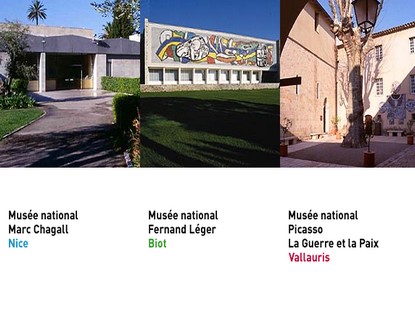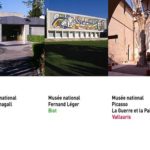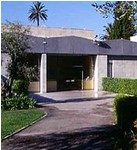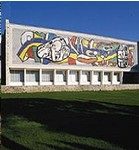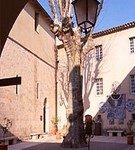The cultural orientations and year-end programs of the three museums, Marc Chagall in Nice, Fernand Léger in Biot, and Pablo Picasso in Vallauris, which represent a center of excellence in the Department.
The editorial by the director and chief curator of heritage Maurice Fréchuret.
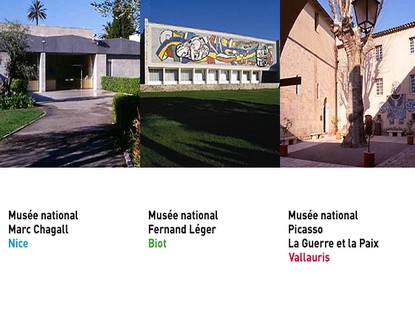
With exhibitions that correspond from one museum to another, cultural programs that complement each other, educational actions adapted to the expectations of all audiences, the national museums of the Alpes-Maritimes work more than ever in unison, proving by that very fact, the validity of the initiative taken over 16 years ago, which brought them together under a single direction.
The ambitious program for the year 2011 will undoubtedly give an even better opportunity to verify the relevance and strength of such a framework. The presentation of permanent collections will, of course and as it should, be ensured and even renewed thanks to different displays that will allow our visitors to better understand the collection of each museum, also thanks to restoration campaigns on the works ensuring a better approach. The exhibitions will be the highlight of this program, particularly with an event of paramount importance that associates the national museums of the 20th Century in the Alpes-Maritimes with many other institutions in the region for the creation of an exceptional project: the presentation of a historic exhibition entitled “Contemporary Art and the Côte d’Azur,” aimed at showcasing 60 years of artistic production (1951-2011).
Following La Côte d’Azur and Modernity, an exhibition that took place in 1997, the one that will open during the summer of 2011 will unveil works by artists living or having lived and worked in the region. This major exhibition will account for what is this “territory for experimentation” which, for more than a century and a half, has operated as a real artistic laboratory. A collaboration with the Museum of Jewish Art and History of Paris will be an opportunity, at the end of this year 2010, to admire an impressive set of works by Franz Kupka around the Song of Songs, which will echo that of the Marc Chagall National Museum.
Other exhibitions will be presented which, deliberately centered on the museum collections, will display, from some chosen themes (circus, illustrated books…), the richness of the conserved collections. The cultural program will also be particularly rich in events throughout the season: art history conferences with the participation of great art historians, exceptional film screenings, concerts organized with the Nice Philharmonic Orchestra and its beautiful Apostrophe ensemble, and a conference organized with the Nice Sophia-Antipolis University, so many highlights that, increasingly followed by our public, will make the news of this new year.
MAURICE FRÉCHURET
CHIEF CURATOR OF HERITAGE,
DIRECTOR OF THE NATIONAL MUSEUMS OF THE 20TH CENTURY IN THE ALPES-MARITIMES
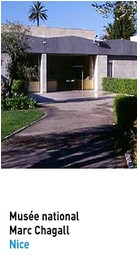
Chagall, Kupka,
Two Visions of the Song of Songs
Exhibition made possible through an exceptional partnership with
the Museum of Jewish Art and History of Paris.
Opening on Saturday, December 4 · 11 a.m.
The exhibition offers museum visitors the opportunity to put into perspective the depiction of the Song of Songs painted by Marc Chagall between 1955 and 1966 and another interpretation of the text, that of Franz Kupka, who worked on it from 1905 to 1931 for an illustrated edition. This love song considered sacred by Jews and Christians and included in the definitive versions of the Old Testament has indeed sparked, over the centuries, many literary and pictorial interpretations. Around Chagall’s paintings are thus gathered preparatory drawings, often in pastel and very rarely shown due to their great fragility. The painter’s inspiration develops from the three dimensions of the poem: carnal, musical, and, of course, religious.
Kupka’s work is presented thanks to the generous loan from the Museum of Jewish Art and History. It includes in particular two series of gouaches: the suite of illustrations in French and the Hebrew suite, the artist having learned Hebrew to complete his drawings with the calligraphed text.
Marked by the symbolism that characterizes Kupka’s beginnings as well as his links with the Vienna Secession, sometimes inspired by contemporary archaeological research in the Middle East, these works, both erotic and poetic, show the passionate and lasting interest of the artist for this project.
Exhibition curators
Maurice Fréchuret,
director of the national museums of the 20th century in the Alpes-Maritimes, chief curator of heritage.
Elisabeth Pacoud-Rème, in charge of collections at the Marc Chagall National Museum.
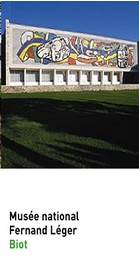
1960 – 2010: THE 50TH ANNIVERSARY OF THE NATIONAL MUSEUM FERNAND LÉGER
November 20, 2010 – May 16, 2011
COLORFUL
The Ceramics of Fernand Léger
Opening on Saturday, November 20, 2010 · 11 a.m.
The exhibition Colorful presents an exceptional set of ceramics created by Fernand Léger at the end of his career, as an extension and culmination of his pictorial production. Around 1950, ceramics took a privileged place within his creations. Like Picasso, Chagall, or Braque, at the same time, Léger began working with this technique during regular stays on the Côte d’Azur.
He collaborated with two former students of his workshop established in Biot, the ceramist Roland Brice and his son Claude. The painter became passionate about this technique which allowed him to move beyond the confines of easel painting and open painting to new dimensions: relief and monumentality. Approaching ceramics with the eye of a painter, Léger plays with reliefs to energize his compositions and animate his famous black outline. In a few years, he moved from producing small reliefs to monumental projects. His polychrome sculptures, designed for public spaces, achieved his ambition for an art accessible to all.
General curator:
Maurice Fréchuret,
director of the national museums of the 20th century in the Alpes-Maritimes, chief curator of heritage.
Ariane Coulondre, curator at the Fernand Léger National Museum.
Nelly Maillard, in charge of research and documentation at the Fernand Léger National Museum.
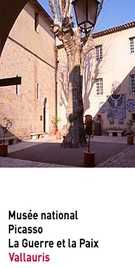
ZINEB SEDIRA
Until November 29, 2010
The works of Zineb Sedira, whether they draw on video, photography, installation, or text, are heavily influenced by the identity search of any individual confronted with different cultures.
Zineb Sedira, a Frenchwoman of Algerian origin, has been living in Great Britain for over twenty years, building her work around the theme of displacement. The subjects she addresses – communication, the body, space, the sea, exile, and their accompanying prohibitions or obligations – speak of what she herself has experienced or encountered in her life, but remain fundamental themes that many artists have explored in the history of modern and ancient art.
Although heavily loaded, the poetic and profound manner in which Zineb Sedira approaches them frees them from pathos and sentimentality. By privileging marginal approaches, giving space to details and fragments, and highlighting the ebb and flow of what innervates the natural or human environment, the artist gives subjects that current events trivialize a dimension that transforms them deeply. The view that Zineb Sedira takes on events remains fundamentally questioning.
The railings, guardrails, or other parapets, so frequent in her videos and photos, are the supports she uses to scan the horizon of an ever-present Mediterranean. They also serve to observe the figures of remoteness, separation, exile, or passage. They are the railings where anyone can come to lean to, along the water, reflect on the meaning of their own existence.
Curator:
Maurice Fréchuret,
director of the national museums of the Alpes-Maritimes,
chief curator of heritage
